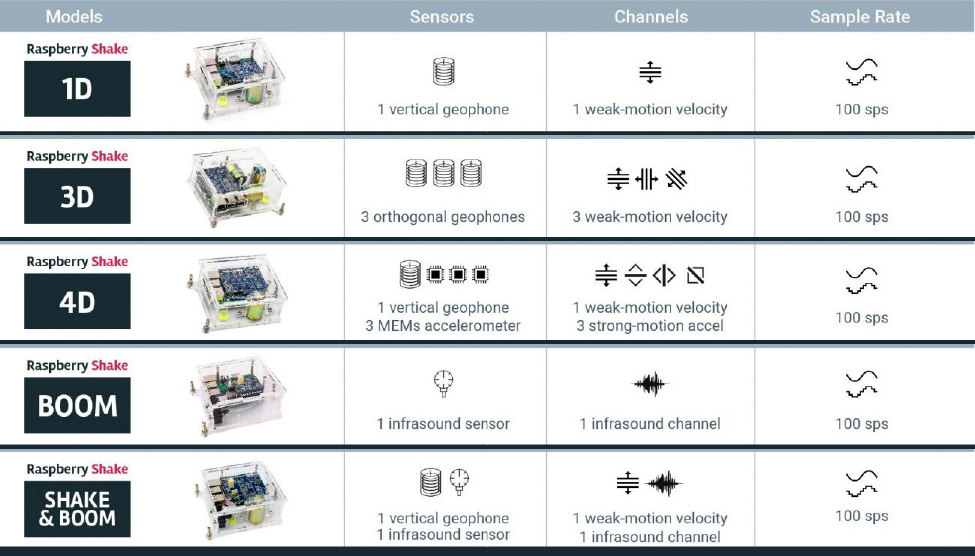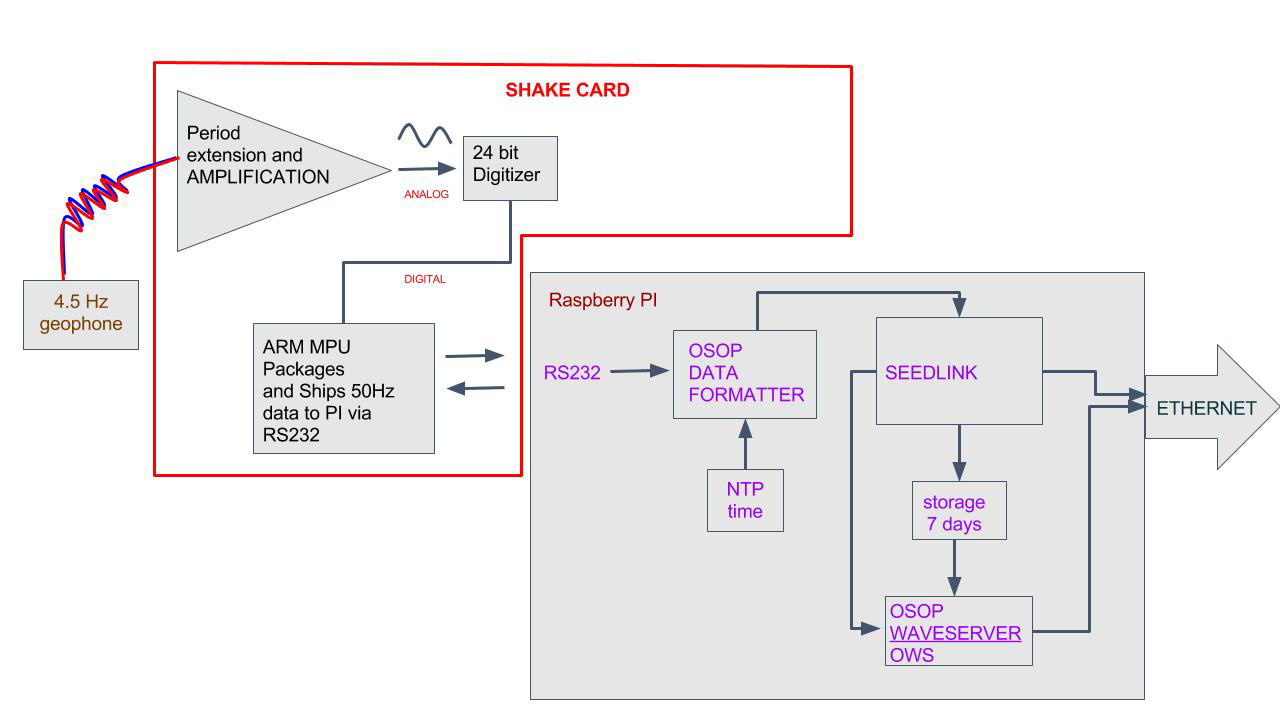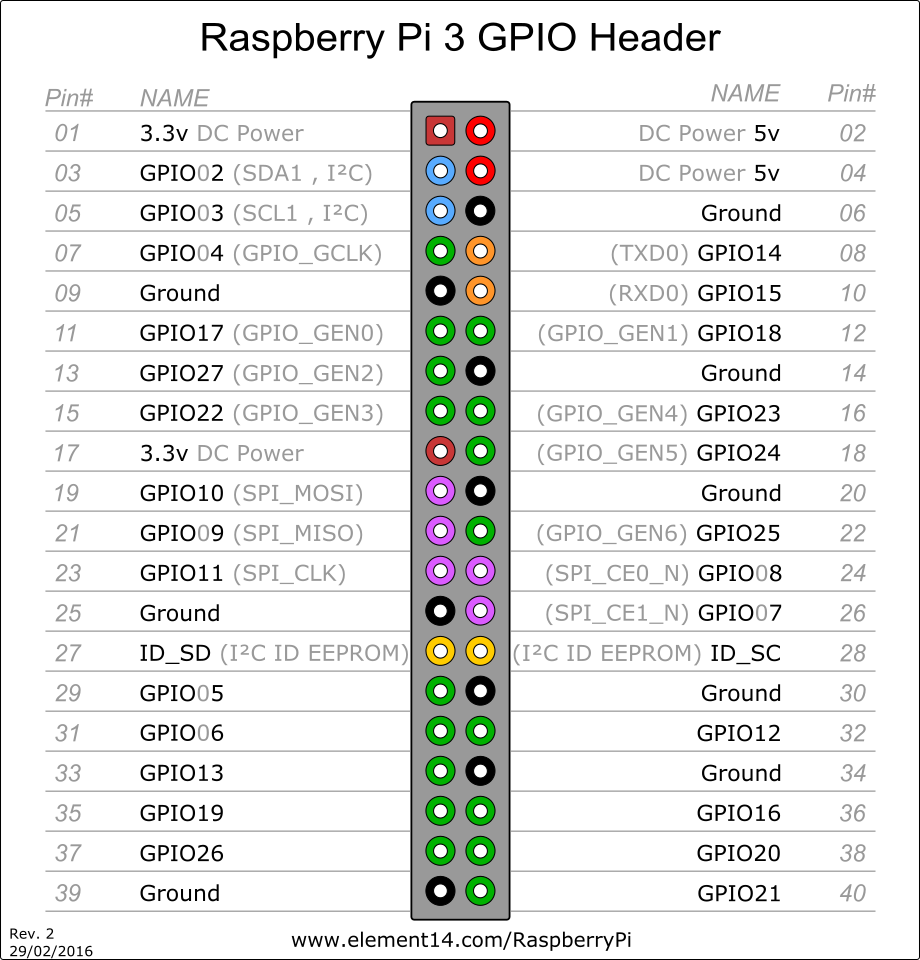Technical Specifications#
Contents
Technical Specifications Documents#
See also: Publications and
herefor an article published by the USGS’s Albuquerque Seismological Laboratory (ASL) on the performance of the Raspberry Shake.
What is the difference between the RS1D, RS3D and RS4D models?#

Click to enlarge#
sps = samples per second on all channels
The RS1D, RS3D, RS4D and RS&BOOM have the same capabilities for detecting Earth motion in the vertical dimension. The RS3D replicates these abilities in the horizontal dimensions, providing the user with a fuller view of earth motion in all 3 dimensions. The difference between the RS1D and the RS4D is that the RS4D has a 3 dimensional accelerometer built into the board. This is interesting for people who live in earthquake zones where the strong motion might be enough to saturate the vertical sensor. With the accelerometer, the Earth motion would remain on scale with the added benefit of being able to detect lateral motion as well.
How does the Raspberry Shake compare to a broadband seismometer?#
See How does the Raspberry Shake compare to a broadband seismometer?
Flow Chart For Raspberry Shake RS1D#

Storage is now user configurable and can be much longer than 7 days, which is the default. Raspberry Shake is also Wifi compatible.
Warning
We do not recommend using the built-in Raspberry Pi board’s Wi-Fi. For more information you can consult this page.
Metadata - Instrument Response Files - Self-Noise#
Timing Quality (NTP)#
In all Raspberry Shake products, data packet time stamps are done using Network Timing Protocol (NTP) time. Timing quality is +/- 10 ms for all products. To give you an idea what this means, consider an earthquake’s P-wave traveling at a very fast 6000 m/s. With an uncertainty of +/- 10 ms, this translates into a location uncertainty of only +/- 60 meters. For lower P-wave velocities, the uncertainties diminish. This uncertainty is well within a reasonable margin of error for locating earthquakes.
Click here for even more timing details: NTP and GPS timing details.
Click here for details on using the USB GPS antenna available for purchase at our shop: GPS Antenna
RPi’s supported#
Any Ethernet- or Wifi-capable Raspberry Pi (RPi) computer can, theoretically, be supported. The only information we need to support an old or new model of the RPi is the serial port where data is read from, where the basic rule is for some specific models the tty port is named /dev/ttyS0 (e.g., Revisions 9000c1 and 920093) and for all others (as a catch-all condition) the tty name is /dev/ttyAMA0.
There is a physical limitation: with the exception of the RS1D, all Raspberry Shake boards have 4 mounting holes. This means that the older Model B which has 2 diagonally positioned mounting holes, is not supported. The Model A+ is also not “technically” supported for this same reason, but all of the software does run on it. You can find Raspberry Shake model-specific information below.
Warning
We do not support or recommend using the Raspberry Pi Zero (any version). Be aware that this version of the Raspberry Pi computer introduces high amplitude RF noise into the Raspberry Shake, seriously compromising the seismic signal by introducing high amplitude low-frequency spikes.
Note
As of now, RS does not (and does not plan to) support the Raspberry Pi 5 Model B. The primary reason behind this decision is that the device’s high-performance characteristics are wholly oversized for what any Raspberry Shake model is designed to do. RS remains focused on supporting Rpi 3 Model B and 4 Model B, both of which more than adequately “get the job done”, and will remain available for the foreseeable future.
The Raspberry Shake RS1D supported modules:
000[d,e]: Model B, Revisions 000[2-9] & 000f lack mounting holes are not supported (please note that we no longer sell the Model B-specific enclosure.)
00[10,13],900032: Model B+
a[01040,01041,21041,22042]: 2 Model B
a[02082,22082,32082,52082]: 3 Model B
a020d3: 3 Model B+
[a,b,c]03111, [b,c]03112, d03114: 4 Model B
The Raspberry Shake RS3D, RS4D and RJAM supported modules:
00[10,13],900032: Model B+
a[01040,01041,21041,22042]: 2 Model B
a[02082,22082,32082,52082]: 3 Model B
a020d3: 3 Model B+
[a,b,c]03111, [b,c]03112, d03114: 4 Model B
Due to the form factor of the Model B (2 mounting holes diagonally-positioned), the Model B is not supported.
The RBOOM and RS&BOOM supported modules:
00[10,13],900032: Model B+
a[01040,01041,21041,22042]: 2 Model B
a[02082,22082,32082,52082]: 3 Model B
a020d3: 3 Model B+
[a,b,c]03111, [b,c]03112, d03114: 4 Model B
Due to the form factor of the Model B (2 mounting holes diagonally-positioned), the Model B is not supported.
For additional information on RPi Revision codes, see: https://www.raspberrypi.org/documentation/hardware/raspberrypi/revision-codes/README.md
GPIO pins#

All Raspberry Shake boards (“hats”) sit on pins 01 through 26. So GPIOs and grounds on pins 27 to 40 are easily available to endusers for other applications. The Raspberry Shake does not, however, use all of the pins from 01 to 26. The following pins are used:
02,04: 5v
06,09,14,20,25: Ground
08,10: Tx/Rx
15: RESET
17: 3.3v
All other pins are available for use. Some have specific functions such as pins 27 and 28, but the others can all be used for general purpose or their specific functions.
Note
The header on the Raspberry Pi computer is the same for the Model B+, 2 Model B, 3 Model B(+).
LED behavior#
Every Raspberry Shake presents a number of LED lights that can give insight on its processes. In particular, when a Shake is turned on and it is working properly, the LED ensemble should display the following colors:
Raspberry Pi board (the one with the USB and LAN ports)
Red light (solid)
Green light (flashing occasionally, every ~2-5 seconds)
Raspberry Shake board (the one above the Pi board, blue in color)
Blue light (solid)
Ethernet port (on the Pi board)
Green light (flashing repeatedly)
Orange light (solid)
If any of these LEDs is not behaving as described in the above list, the Shake is not working as it should, and the issue can be solved with our Technical Support assistance.
IP67 M12 connector specifications#
Note
The supported standard for the IP67 LAN connector is 100 Mbit/s (4-wired LAN cable).
See Raspberry Shake IP67 M12 Connectors
RJAM-specific: see: RJAM Cable diagram and connector specifications.
Note
If you are planning to use a longer cable than we provide, be sure to calculate the wire gauge needed in order to minimize any loss of voltage. The RPi requires 5.1 V at 2.5 Amps to boot properly.
Networking#
All Raspberry Shake models provide a built-in Ethernet port on the integrated Raspberry Pi board for network access. This connection is used for data transmission, real-time monitoring, remote configuration, and software updates.
Flexible Connectivity Options
Because the connection is standard Ethernet, any RS can be linked to any modem or gateway that supports this technology, such as:
Home or Office Internet modems and routers
Cellular gateways (GPRS, 3G, 4G, 5G)
Point-to-point radio or WiFi bridges
Satellite Internet systems
Low Earth orbit constellations such as Starlink